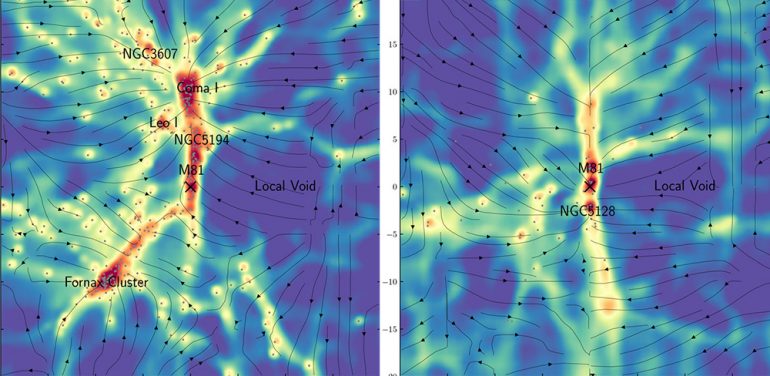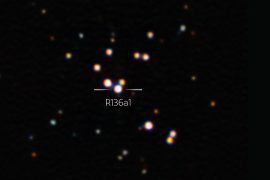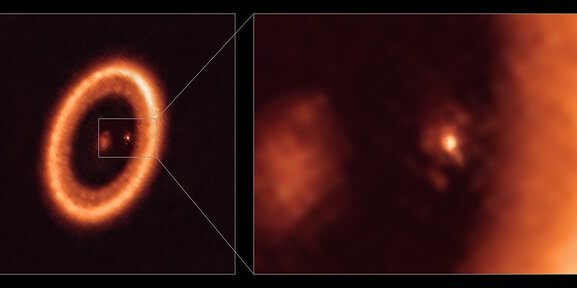Invisible Fibers: A new mapping shows the distribution of dark matter around the galaxy – and reveals some previously unknown structures. It consists of several small fibers that connect neighboring galaxies. According to astronomers in the “Astrophysical Journal”, this close look at the hidden streams of matter in our cosmic atmosphere can help to clarify the nature of dark matter.
Dark Matter is as ubiquitous as it is mysterious in the universe. Because what is in it and what are its features is completely unknown. It only seems clear that its gravity shapes the behavior of normal matter and its distribution in the universe. However, how the dark matter itself is distributed can only be determined indirectly by astronomers, for example by the motion of star currents or galaxies.
Barely mapped near the structure
Pennsylvania State University co-author Donghui Jeong explains, “Ironically, it is easier to map the distribution of dark matter far away than in our neighborhood.” “Because in the distant past the universe was less complex.” Most of the previous ones Mapping Therefore the Dark Matter distribution is based on the observation or simulation of structures billions of light years away.
However, how Dark Matter is distributed in the area around our Milky Way and local conglomerates is largely unknown. Reason: On the one hand, portions of nearby structures are covered by the Milky Way, on the other hand, the motion of galaxies is also affected by factors other than Dark Matter, as Jeong and his colleagues point out. But if you have only a few galaxies, such as the nearby universe, then it is more difficult to calculate these disruptive factors.
Help from artificial intelligence
To solve this dilemma, the team around Jeong and the first author Sungwook Hong of Seoul University used a new approach: they used an artificial intelligence for mapping. First, he trained this adaptive program on a set of simulations that map the characteristics and distribution of galaxies, interstellar matter, and dark matter. Researchers focused on data sets that contained galaxies and many galaxies similar to those around them.
Using this training data, artificial neural networks learned how galaxies’ distance, brightness, and proper speed are related to the density and presence of dark matter in their atmosphere. “Based on what has been learned, the system can now recognize detailed structures in new data and close some gaps,” Jeong explains.
For real mapping, the AI then obtained data from the Cosmicflow 3 galaxy catalog on 17,647 galaxies in a range of 65 million light-years around the galaxy. From this information, the system determined the distribution and density of dark matter in our local area.
See “dark” filaments
A map created using AI now shows for the first time how Dark Matter is distributed in our local universe. The researchers say, “The most important feature we uncovered is the filamentary structure of the local cosmic network.” The map clearly shows that dark matter is distributed in a network-like structure around us. Their local distribution is thus similar to that seen in the distant, early universe.
“Having such a map of local cosmic networks opens up a new chapter in cosmological studies,” says Jeong. “Because now we can research how the local distribution of dark matter is related to other astronomical data, such as some radiation emissions.”
This in turn may provide information about the still mysterious nature of dark matter. According to one hypothesis, particles of dark matter can destroy each other by emitting X-rays or gamma rays. If this is true, then this radiation should be higher in areas where there is a higher density of dark matter – the new mapping now enables this comparison.

Micro-dynamics of our environment
The new map also provides insight into the dynamics and gravitational connections of many visible objects in the local universe. For example, it shows many famous large structures such as Local zero, A relatively empty area in space, on the edge of which our Milky Way is located. “The motion data shows how the material moves from local zeros to nearby filament structures and galaxy clusters,” the researchers point out.
Some of the larger filaments on the local comic network also appear in the new map. One of these is the one that was discovered in 2015 Dark matter bridge Between the local cluster and the Virgo supercluster, but also the Fornax Wall, a filament that connects several galaxy clusters. According to astronomers, this proves that the new 3D map captures the interaction and dynamics of visible and invisible matter well.
Unfamiliar structures
But exciting: Mapping also reveals some new, previously known structures. It consists of several small dark matter bridges that connect neighboring galaxies. “With the help of new maps, we now know where these filament structures are and thus can directly examine these hidden bridges between galaxies,” says Jeong.
The only recently improved rectification of dwarf galaxies, spherical clusters and star currents in the area around the Milky Way is also new. local level. It covers a plate-shaped region approximately 20 million light years in diameter, with the Milky Way and the Andromeda galaxy surrounded by twelve large galaxies.
Knowledge of these structures and abnormalities can now provide more information about how our cosmic environment is today. “Since Dark Matter dominates the dynamics of the universe, it also determines our fate,” Jeong says. If we know the rules behind their current distribution, we can virtually reverse time and fathom the history of our cosmic neighborhood. (Astrophysical Journal, 2021; Doi: 10.34 / 1537-4356 / ABF060)
She: Pennsylvania State University

Internet fan. Alcohol expert. Beer ninja. Organizer. Certified tv specialist. Explorer. Social media nerd.





